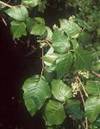Abstract
Florida parks and woodlands are favorite places for many people who enjoy outdoor activities. Unfortunately, the native plants poison ivy, poison oak, poison sumac, and poisonwood can make these outings a miserable experience. All four contain urushiol, a plant oil that can cause a severe skin rash (dermatitis) when any part of the plant is contacted. Allergic reaction can occur directly by touching the plant or indirectly by coming into contact with the oil on animals, tools, clothes, shoes, or other items. Even the smoke from burning plants contains oil particles that can be inhaled and cause lung irritation. This revised 6-page fact sheet helps individuals learn to identify these plants in order to avoid contact with them. Children should be taught to recognize these plants, particularly poison ivy, as it is by far the most common. Written by Sydney Park Brown and SettingsJoe Sewards, and published by the UF Department of Environmental Horticulture, March 2012.
ENH886/EP220: Identification of Poison Ivy, Poison Oak, Poison Sumac, and Poisonwood (ufl.edu)
References
Cook, W. 2012. "Trees, Shrubs, and Woody Vines of North Carolina." Accessed February 2012. http://www.duke.edu/~cwcook/trees/.

